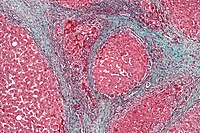
Photo from wikipedia
PurposeRecent clinical data suggest that terlipressin, a vasopressin analogue, may be more beneficial in septic shock patients than catecholamines. However, terlipressin’s effect on mortality is unknown. We set out to… Click to show full abstract
PurposeRecent clinical data suggest that terlipressin, a vasopressin analogue, may be more beneficial in septic shock patients than catecholamines. However, terlipressin’s effect on mortality is unknown. We set out to ascertain the efficacy and safety of continuous terlipressin infusion compared with norepinephrine (NE) in patients with septic shock.MethodsIn this multicentre, randomised, double-blinded trial, patients with septic shock recruited from 21 intensive care units in 11 provinces of China were randomised (1:1) to receive either terlipressin (20–160 µg/h with maximum infusion rate of 4 mg/day) or NE (4–30 µg/min) before open-label vasopressors. The primary endpoint was mortality 28 days after the start of infusion. Primary efficacy endpoint analysis and safety analysis were performed on the data from a modified intention-to-treat population.ResultsBetween 1 January 2013 and 28 February 2016, 617 patients were randomised (312 to the terlipressin group, 305 to the NE group). The modified intention-to-treat population comprised 526 (85.3%) patients (260 in the terlipressin group and 266 in the NE group). There was no significant difference in 28-day mortality rate between the terlipressin group (40%) and the NE group (38%) (odds ratio 0.93 [95% CI 0.55–1.56]; p = 0.80). Change in SOFA score on day 7 was similar between the two groups: − 7 (IQR − 11 to 3) in the terlipressin group and − 6 (IQR − 10 to 5) in the NE group. There was no difference between the groups in the number of days alive and free of vasopressors. Overall, serious adverse events were more common in the terlipressin group than in the NE group (30% vs 12%; p < 0.001).ConclusionsIn this multicentre, randomised, double-blinded trial, we observed no difference in mortality between terlipressin and NE infusion in patients with septic shock. Patients in the terlipressin group had a higher number of serious adverse events.Trial registrationThis trial is registered at ClinicalTrials.gov: ID NCT01697410.
Journal Title: Intensive Care Medicine
Year Published: 2018
Link to full text (if available)
Share on Social Media: Sign Up to like & get
recommendations!